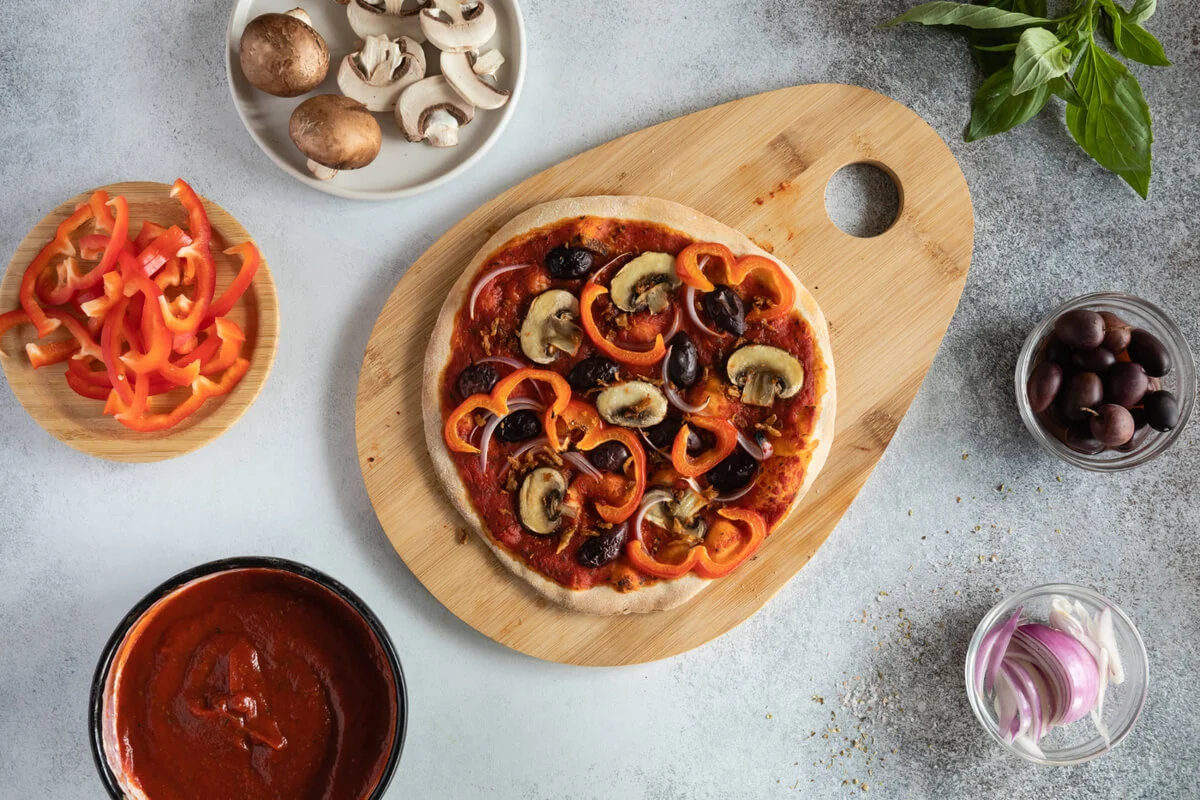Introduction
When it comes to pizza, the crust is the foundation of flavor and texture. While the toppings might steal the spotlight, the crust holds it all together, both literally and figuratively. A crispy crust is what turns a good pizza into a great one, adding that satisfying crunch with every bite. But achieving this at home often raises the question: How do I make my crust more crispy?
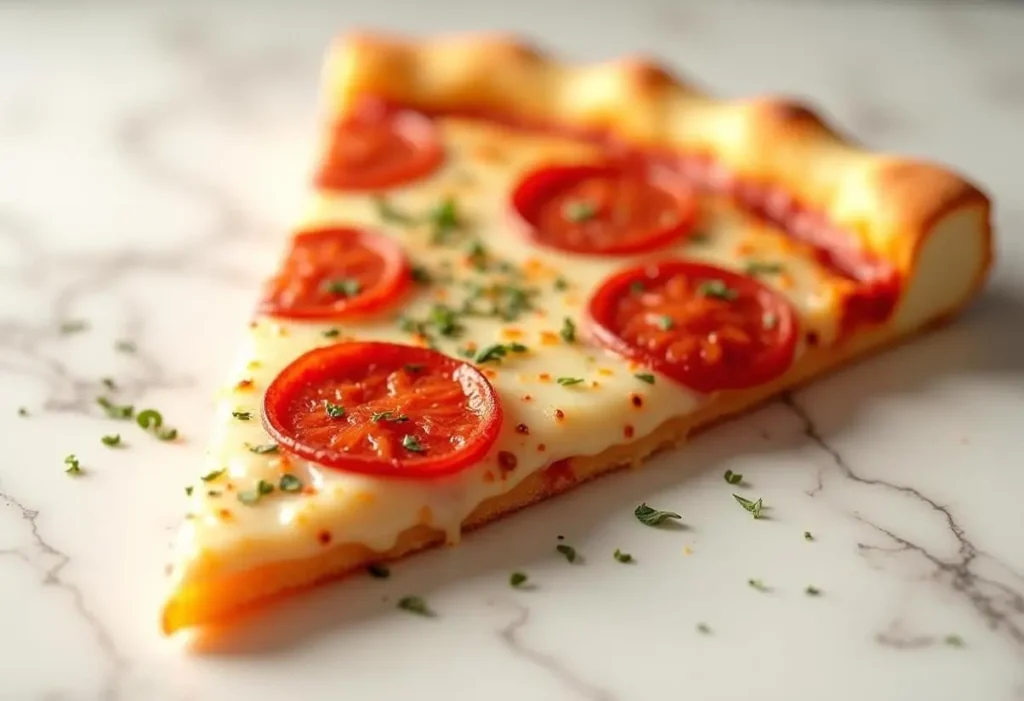
Home cooks face several challenges, such as making the crust crispy without specialized equipment like a pizza stone or ensuring the bottom doesn’t turn out soggy. Yet, with the right techniques and a few key adjustments, even the simplest homemade pizzas can rival those from your favorite pizzeria.
This guide will explore various methods, from perfecting dough hydration to mastering oven techniques. Whether you’re looking to make your pizza crust crispy on the bottom or trying to avoid a limp and chewy texture, we’ll cover all the tips and tricks to elevate your pizza-making game. So, let’s unlock the secrets to creating that perfect crust.
Understanding the Science Behind Crispy Pizza Crust
What exactly makes a pizza crust crispy? The answer lies in a combination of factors that work together to create that perfect texture. From the ingredients in the dough to the way heat is distributed during baking, every step plays a crucial role.
The Role of Hydration Levels in the Dough
Hydration refers to the water-to-flour ratio in your dough. Lower hydration levels (50–60%) result in firmer dough that crisps up more easily in the oven. Conversely, overly wet dough can produce a softer, chewier crust. Striking the right balance ensures the moisture evaporates during baking, leaving behind a crispy texture.
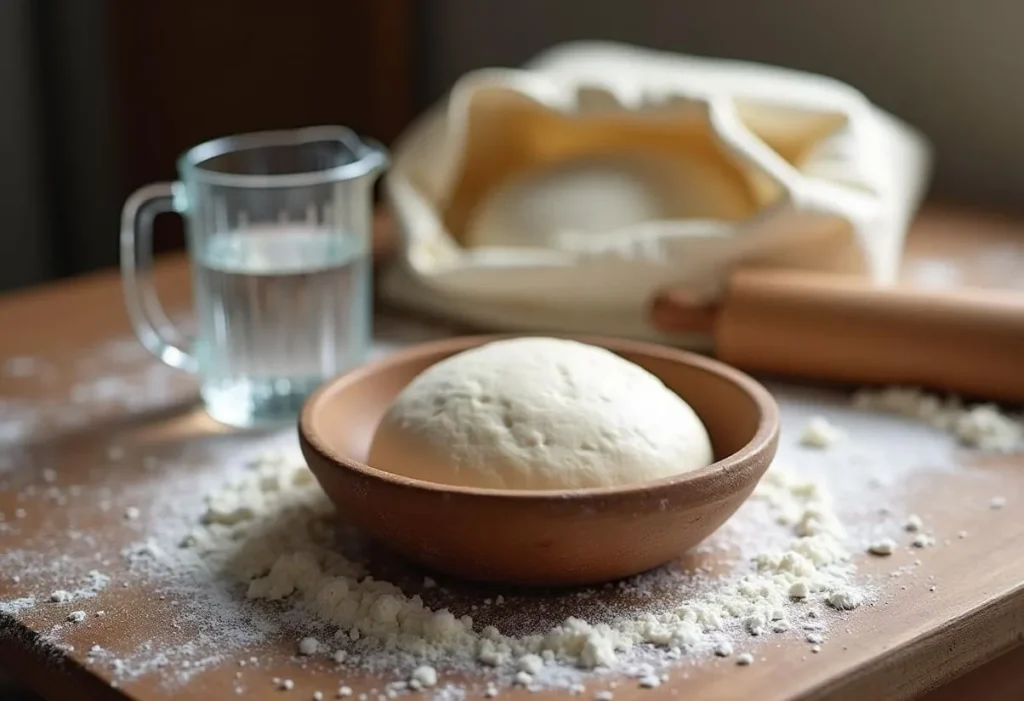
Impact of Baking Temperatures and Time
High temperatures are key to achieving a crispy crust. Most professional pizzerias bake at 800°F or higher, but home ovens typically max out around 500°F. To mimic professional results, preheat your oven for at least 30 minutes and use a pizza stone or steel to retain and evenly distribute heat. Baking time is equally important—too short, and the crust remains doughy; too long, and it can become overly brittle.
How Air Circulation in the Oven Affects Crispiness
Proper air circulation ensures even heat distribution. Convection ovens excel at this by circulating hot air, which helps moisture escape from the dough surface. For traditional ovens, placing your pizza on a lower rack can help achieve similar results by exposing it to direct heat from the bottom.
What Makes a Crust Crispy?
Ultimately, achieving a crispy crust requires balancing dough hydration, baking at the right temperature, and ensuring proper airflow. Together, these factors create the golden-brown, crunchy crust we all love.
Choosing the Right Ingredients
When it comes to making a crispy pizza crust, the choice of ingredients can make all the difference. From the type of flour to the addition of specific enhancers, understanding how each ingredient contributes to crispiness is essential for success.
Flour Type: High-Protein vs. All-Purpose Flour
The foundation of any pizza crust starts with flour. High-protein flours, like bread flour or 00 flour, contain more gluten, which gives the dough elasticity and structure. This strength allows the crust to hold its shape during baking, leading to a crispier texture. In contrast, all-purpose flour, while versatile, has a lower protein content, which can result in a softer, less structured crust. For the crispiest results, opt for high-protein flours.
Importance of a Proper Water-to-Flour Ratio
The water-to-flour ratio, or hydration level, determines the dough’s texture. A hydration level between 60–65% is ideal for achieving a crispy crust. Too much water can make the dough sticky and challenging to handle, while too little can result in a dry, crumbly dough. Measure your ingredients precisely to ensure consistency.
Adding Olive Oil or Sugar for a Better Crust Texture
Olive oil not only enhances the dough’s flavor but also helps create a crisp outer layer during baking. Similarly, adding a small amount of sugar can promote browning and caramelization, giving the crust a golden, crispy finish. Use these ingredients sparingly to avoid overpowering the dough.
Actionable Tips for Recipe Adjustments
- Use bread or 00 flour for a stronger, more elastic dough.
- Add 1–2 tablespoons of olive oil to your dough recipe for extra crispiness.
- Incorporate a teaspoon of sugar to enhance browning.
- Measure your ingredients by weight for precise hydration levels.
By selecting the right ingredients and fine-tuning your recipe, you’ll be well on your way to creating a crispy, restaurant-quality crust at home.
Mastering Techniques for Crispy Pizza Crust
If you’ve ever wondered, “How do I make my crust more crispy at home?”, mastering a few key techniques can make all the difference. These methods ensure that your pizza crust achieves the perfect balance of crunch and texture, even in a home oven.
How to Stretch the Dough for Optimal Thinness
One common mistake is rolling the dough too thick, which can lead to a dense or doughy crust. Instead, gently stretch the dough using your hands to maintain its elasticity. Start from the center and work outward, rotating the dough as you go. A thinner base cooks faster and crisps up more evenly. Avoid overworking the dough, as this can make it tough.
Importance of Preheating the Oven and Using a Baking Sheet or Stone
Preheating your oven is crucial for a crispy crust. A hot oven ensures that the dough begins to crisp up immediately, locking in moisture without turning soggy. Preheat your oven to its maximum temperature, typically 475–500°F, for at least 30 minutes.
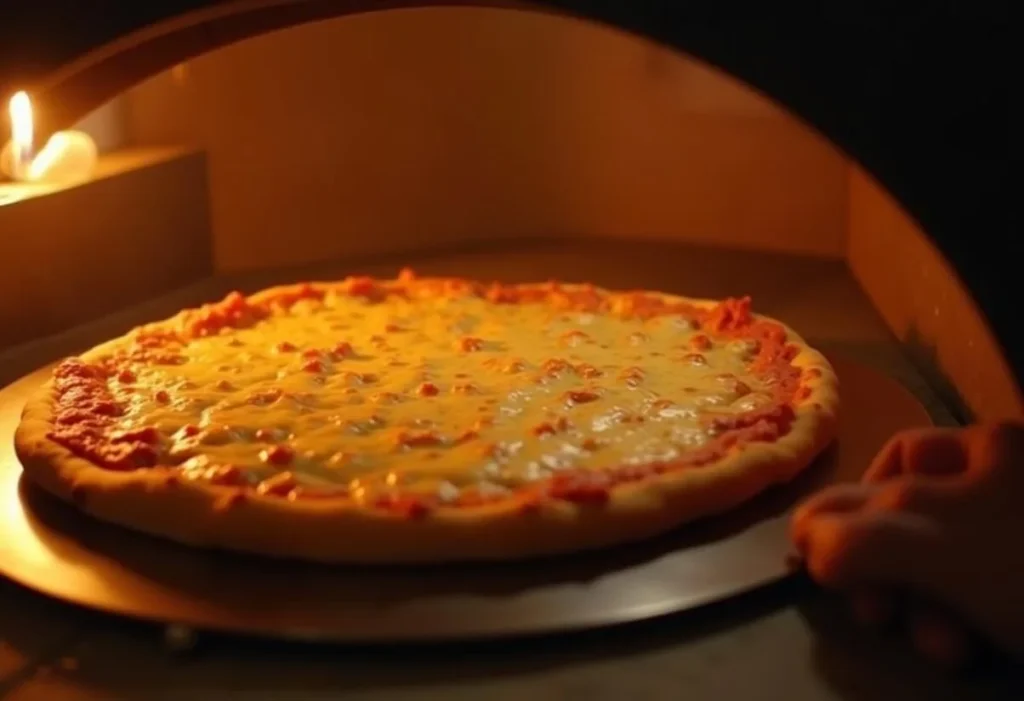
Using a pizza stone or baking steel can further enhance crispiness by providing direct, even heat. Place the stone or steel in the oven during preheating, then slide the pizza onto the hot surface. If you don’t have a stone, an inverted baking sheet can serve as a good alternative.
Adjusting Bake Time for Different Ovens
Ovens vary, so it’s important to adjust your bake time accordingly. A general guideline is to bake pizza for 8–12 minutes, checking frequently after 8 minutes. If the edges are crisp but the bottom still feels soft, move the pizza to a lower rack for an additional minute or two.
How to Make Pizza Crust Crispy in the Oven
For a crispy crust in a conventional oven:
- Preheat the oven and baking surface to 500°F.
- Use a thin layer of flour or cornmeal on your peel or baking sheet to prevent sticking.
- Bake the pizza on the lowest rack to expose the crust to direct heat.
With these techniques, you’ll have the answer to the question, “How do I make my crust more crispy at home?”—and a pizza that rivals any pizzeria’s.
Techniques for a Crispy Crust Bottom
A crispy crust bottom is a key feature of a perfect pizza. If your crust often turns out soggy or unevenly cooked, there are proven methods to ensure that the base achieves a crisp, golden finish. Here’s how to make pizza crust crispy on the bottom and enjoy a professional-grade pizza at home.
Using a Perforated Pizza Pan or Cast Iron Skillet
A perforated pizza pan allows hot air to circulate beneath the dough, ensuring even cooking and a crispy bottom. These pans are specifically designed to prevent moisture buildup, making them ideal for thin-crust pizzas.
Alternatively, a cast iron skillet can achieve similar results. The skillet retains heat exceptionally well, creating a searing effect on the dough’s surface. Preheat the skillet in the oven, carefully add the dough, and return it to the heat for a perfectly crispy bottom.
Pre-Baking the Crust Before Adding Toppings
Pre-baking, or par-baking, the crust can significantly improve crispiness. Simply bake the plain dough for 5–7 minutes before adding sauce, cheese, and toppings. This step helps remove excess moisture from the dough and gives the crust a head start in crisping up.
To prevent bubbling, poke the dough lightly with a fork before pre-baking. This technique is especially useful when using heavier toppings or wetter ingredients, as it keeps the crust from becoming soggy.
Ensuring Toppings Don’t Weigh Down the Crust
Excessively heavy or wet toppings, like fresh tomatoes or thick sauces, can make it challenging to achieve a crispy crust. Use toppings sparingly and consider drying moisture-rich ingredients with a paper towel before applying them to the pizza.
For an even crispier base, sprinkle a light layer of cornmeal or semolina on your pizza peel or baking surface. These grains create a barrier that prevents sticking and adds an extra layer of crunch.
How Do I Make My Bread Crust Crispy?
To make bread or pizza crust crispy:
- Bake at high heat with steam during the first few minutes.
- Use a stone or steel to evenly distribute heat.
- Cool the bread or pizza on a wire rack to prevent trapped steam from softening the bottom.
With these methods, you’ll master the art of creating a crispy pizza crust bottom every time.
Achieving Crispy Crust Without Specialized Tools
Not everyone has a pizza stone, but that doesn’t mean you can’t create a crispy crust at home. There are plenty of effective alternatives and methods to achieve the same results. Let’s explore how to get crispy pizza crust without a pizza stone using simple tools and techniques.
Alternatives to Pizza Stones: Baking Steel and Inverted Baking Trays
A baking steel is an excellent substitute for a pizza stone. Made of durable steel, it retains and distributes heat more effectively, helping the dough cook evenly and achieve a crispy finish. If you don’t have a baking steel, an inverted baking tray works surprisingly well.

To use an inverted baking tray:
- Preheat the tray in the oven for at least 30 minutes.
- Transfer your pizza onto the hot surface using parchment paper or a pizza peel.
- Bake as usual, ensuring the direct contact with the hot metal promotes crispiness.
Using Parchment Paper for Better Crispiness
Parchment paper is a simple but effective tool. It prevents sticking and allows for easier transfer of the pizza to and from the oven. While parchment doesn’t absorb moisture like a pizza stone, it helps the dough bake evenly, especially when paired with a hot tray or steel.
Adapting Oven Settings for Optimal Results
Maximizing your oven’s capabilities is key to achieving a crispy crust without specialized tools. Increase the temperature to 475–500°F and bake your pizza on the lowest rack to expose the crust to direct heat. Preheating the oven thoroughly ensures even baking and helps replicate the intense heat of a pizza oven.
For added crispiness, turn on the broiler during the last 1–2 minutes of baking. This creates a quick burst of high heat, crisping up the edges and bottom of the crust.
With these techniques, you can confidently make a delicious, crispy pizza crust at home—no pizza stone required!
Troubleshooting Common Pizza Crust Issues
A soft or soggy crust can ruin an otherwise perfect pizza, but it’s a fixable problem. Whether it’s due to excess moisture, under-baking, or other common issues, there are steps you can take to salvage your pizza and restore its crispiness.
Identifying Causes of Soggy Crusts
The most common culprit of a soggy crust is moisture. Wet ingredients like fresh tomatoes or overly watery sauces can seep into the dough, preventing it from crisping up. Similarly, too much cheese or heavy toppings can weigh down the crust, trapping steam and leaving it limp.
Under-baking is another issue. If the oven isn’t preheated or the baking time is too short, the crust won’t develop the crisp outer layer necessary for structural integrity.
Steps to Crisp Up a Soft Crust Post-Baking
If your crust is already soft, you can still rescue it:
- Return it to the oven: Place the pizza directly on the oven rack or a preheated baking sheet to expose the bottom to more heat. Bake at 400–450°F for an additional 3–5 minutes.
- Use a skillet: Heat a dry cast iron skillet over medium heat, then add your pizza. Press it gently with a spatula to encourage direct contact with the hot surface. Cook for 2–3 minutes to crisp up the bottom.
- Broil for a few minutes: If the top of the pizza is fine but the crust needs more crunch, use the broiler for 1–2 minutes to finish it off.
How Do I Make My Crust Crispy Again?
The key to restoring crispiness is applying direct heat to the crust. For best results, avoid reheating in the microwave, as this creates steam and softens the crust further. Instead, use an oven, skillet, or toaster oven to reheat and crisp it up effectively.
Actionable Tips to Prevent Soggy Crusts
- Use a light layer of sauce and drain wet toppings before use.
- Always preheat your oven and baking surface thoroughly.
- Opt for par-baking to strengthen the crust before adding toppings.
By troubleshooting and applying these fixes, you can ensure a consistently crispy crust every time.
For additional tips on troubleshooting soggy pizza crusts, explore this resource.
Frequently Asked Questions About Crispy Pizza Crusts
What is the secret to crispy pizza crust?
The secret to a crispy pizza crust lies in three key factors: high heat, proper dough hydration, and effective moisture control. Using a hot oven (475–500°F) ensures the crust cooks quickly and evenly. A dough hydration level around 60–65% provides the right balance of elasticity and moisture for a crispy finish. Additionally, avoiding overly wet toppings and preheating your baking surface (pizza stone, steel, or inverted tray) can significantly improve the crispiness.
How to make crust crispy in a conventional oven?
To make your crust crispy in a standard home oven, preheat the oven and baking surface to its maximum temperature (typically 475–500°F) for at least 30 minutes. Use the lowest rack for optimal heat exposure to the bottom of the crust. Baking the pizza directly on a preheated surface like a pizza stone or baking steel helps mimic the high, direct heat of a professional pizza oven.
Can you achieve crispiness with gluten-free dough?
Yes, gluten-free dough can still achieve crispiness with the right techniques. Since gluten-free dough lacks the structure of traditional dough, using a binding agent like xanthan gum is essential. Baking on a preheated surface (e.g., stone or steel) and ensuring a thin, even dough layer are also important. Consider par-baking the crust before adding toppings to prevent sogginess and enhance the texture.
How does resting the dough improve crispiness?
Resting the dough allows the gluten (or alternative binding agents in gluten-free dough) to relax, making it easier to stretch and achieve an even thickness. It also enhances the crust’s texture by allowing the yeast to ferment and develop a stronger structure. Rested dough cooks more evenly, leading to a crispier and better-tasting crust.
With these answers, you’ll have the knowledge to tackle common questions and perfect your crispy pizza crust!
Conclusion
Achieving a crispy pizza crust is the cornerstone of creating a truly exceptional pizza. By mastering the techniques outlined in this guide, you can answer the common question: How do I make my crust more crispy? Whether it’s using high-protein flour, preheating your oven, or experimenting with equipment like baking steels and cast iron skillets, each step brings you closer to that golden-brown, crunchy perfection.
Remember, the secret to crispiness lies in attention to detail: proper hydration levels in your dough, avoiding overly wet toppings, and leveraging high heat for baking. Even if you don’t have specialized tools like a pizza stone, alternatives like inverted baking trays or parchment paper can deliver excellent results.
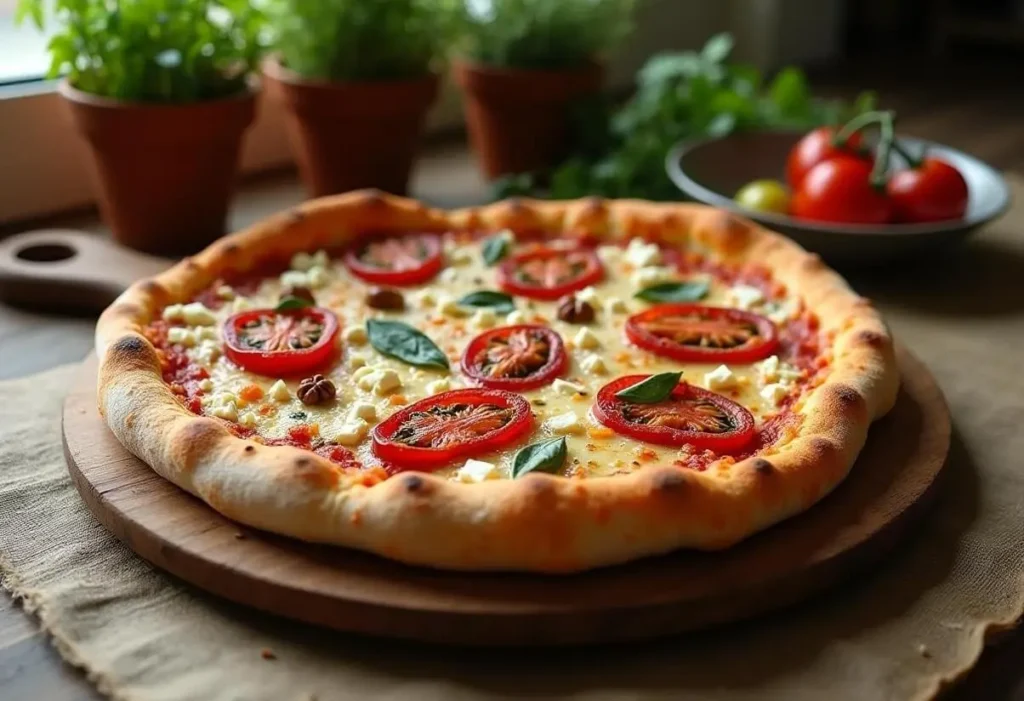
The bottom line is that mastering a crispy crust not only enhances the texture of your pizza but elevates the entire dining experience. A well-crafted crust provides the perfect base for your toppings and ensures every bite is as satisfying as the last.
Now it’s time to put these tips into practice! Try these methods in your kitchen and experiment to find what works best for you. Don’t forget to share your results—your crispy pizza success stories could inspire others to perfect their own crusts.
Enjoy your pizza-making journey!

